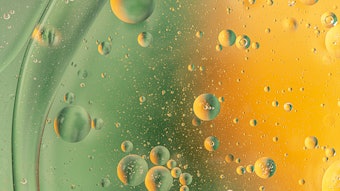This is an edited version of an article that originally ran in the October 2012 issue of Skin Inc. magazine. All rights reserved.
Editor’s note: Sam Dhatt will be presenting further on this concept at the Face & Body Midwest Spa Conference & Expo 2013’s Advanced Education Conference Program on March 9, 2013. Visit www.faceandbody.com/midwest for more details.
Since the dawn of time, humans have stumbled upon various natural ways to keep their skin youthful-looking—even if they didn’t know why a certain method worked. Cleopatra’s milk baths maintained her beauty, and it is known today that the lactic acid in the milk served as a gentle exfoliant. The ancient people of the Mediterranean and Middle East treated their skin and hair with the olives they cultivated; today it is known that the olive’s flavanoid polyphenols are powerful antioxidants. For centuries in Japan, Kabuki performers and geisha removed their makeup and fought hyperpigmentation with nightingale droppings; today it is known that the droppings contain natural enzymes, such as guanine, an amino acid with ammonic bleaching qualities. And the list goes on.
The modern consumer has a huge advantage, not only in knowing why these ancient methods worked, but also in having access to breakthrough technological discoveries that vastly increase their effectiveness. Cells can be extracted from blossoms long-prized for their beauty and fragrance—such as edelweiss, gardenia and sea fennel—then cultivated in a laboratory to multiply their molecular potency by literally 1,000 times or more. This concentration, not available in a raw state, allows the product to deliver a powerful dose of active ingredients to the consumer. It brings together the best of the botanical and clinical worlds.
What Consumers Want
Beauty brand owners and marketers can often feel overwhelmed by what consumers require. The truth is, they want it all. It’s no secret that the anti-aging market continues to be the epicenter of the skin care industry. Every brand, from the drug store house-label to the most elite spa trademark, discusses the anti-aging properties of products and treatments; even brands oriented toward young consumers now lay the groundwork for anti-aging practice in their marketing positioning. However, the consumer’s definition of anti-aging results has shifted significantly in the past few years, requiring increasingly versatile and sophisticated product formulations. A generation ago, the key concern was wrinkles.
Then, a 2006 study released by Karl Grammer, PhD, founder and scientific director of the Ludwig-Boltzmann-Institute for Urban Ethology at the University of Vienna, Austria, added a new twist, pointing to the importance of skin tone—defined as consistent distribution of pigmentation—as a trait that mattered at least as much as wrinkles in determining a woman’s perceived age and relative attractiveness. These findings have ignited consumers’ awareness, expanded their expectations, and resulted in a flurry of new lightening, brightening and whitening products to arrest and reverse hyperpigmentation.
Besides achieving smoothly textured and evenly pigmented skin, a third requirement of today’s skin care consumer is the need for the facial contour and silhouette to be kept taut and sleek, firmly supported by a robust collagen and elastin infrastructure.
These three issues—wrinkles, skin tone and firmness—have led to the recent explosion of research resulting in the Botox revolution and other injectables, laser treatments, microdermabrasion and myriad other in-office medical procedures. In addition, a growing number of eco-minded consumers now also demand the smallest possible carbon footprint for products and services they purchase, including environmental sustainability in the formulation of skin care products.
Plant stem cells may help your brand and its products to meet and surpass consumers’ expectations in all of these areas at the same time. Today’s new generation of plant stem cell products offers beauty brands the ability to stay current, viable and profitable in a swiftly changing industry.
A Detailed Explanation
How exactly does stem cell technology work? Stem cells in plants are referred to as meristematic, or undifferentiated cells. These chameleonlike cells, carrying the entire DNA gene expression of the plant, can morph, or differentiate, into other cell types to help the plant regenerate. This ability makes them invaluable in any number of medical and cosmetic applications.
The first step is to generate the meristematic cells by slightly cutting the plant. Triggered by the wound, plant hormones called auxins cause the plant to form a defensive response called a callus. In this callus tissue, normal differentiated cells revert to de-differentiated cells and become the stem cells, which then may be used in stem cell technology. In other words, the experience of being wounded “un-scripts” plant cells, erasing their role definition, so that they become neutral in terms of their function. This capacity to return to a neutral state is known as totipotency. By contrast, adult human stem cells exhibit multipotency, using a few cells drawn from an organ to generate an entirely new organ, just as the severed arm of a starfish can generate a whole new starfish. Scientists are investigating this potential means to regenerate damaged tissues, such as neural brain tissue after a stroke or blood cells for marrow replacement.
Next, the meristematic cells are cultured in a laboratory setting. There, the concentration of phenylpropanoids—active substances created in response to injury or trauma—is multiplied in these cells by 1,000 times or more. As the stem cells are cultured in this manner, their chemical purity is also enhanced, unlike traditional botanicals, allowing for more influence in safety, control and standardization. When the finished product is applied topically, it works to trigger self-renewal in human skin. This effect is further enhanced by the interaction of high percentages of polysaccharides, phytosterols, amino acids and mineral salts—substances that work synergistically to allow self-repair of the skin.
Plant Stem Cell Technology
According to Mibelle Biochemistry, the earliest plant stem cell research was done using a unique variety of apples in 18th-century Switzerland, which had been hybridized to store well without rot in the days before refrigeration. The self-preserving nature of this plant, suggesting exceptional cell longevity, led to research that gave rise to early applications of plant stem cells for cosmetic use. Alpine rose, butterfly bush and coneflower were also early successes in the field.
Today’s newest powerhouses in this area—including edelweiss, gardenia and sea fennel—offer several benefits for the skin, such as effective protection from photodamage and oxidative stress; a tonic and re-energizing effect on tired skin; and deep, firming action to restore skin elasticity and contour around the jaw line and nasolabial areas, especially in mature skin.
Edelweiss. Edelweiss, which flourishes in harsh mountainous climates, produces several active substances to protect against the elements, including UV rays. The high concentrations of leontopodic acids A and B it produces have antioxidant properties, as well as anti-collagenase and hyaluronidase activity, potentially resulting in wrinkle-reduction.
Sea fennel. Sea fennel is available in the form of a 100% pure active powder, is not diluted, has no preservatives and has a natural delivery system. The stem cells from sea fennel are used as a brightening, anti-aging and skin-renewal ingredient.
Gardenia. The tropical gardenia contains the antioxidant ferulic acid, aiding collagen and hyaluronic acid in the skin. It supports the skin’s infrastructure for improved contour and firmness, and enhances moisture retention. Traditional Chinese medicine has long-prescribed the gardenia as a remedy to ease edema, headache, hypertension and other forms of inflammation.
Communicating the Benefits
Throughout the past few years, especially during political campaigns, stem cell research in reference to human stem cells has made headlines as a controversial subject. Yet, there is absolutely no relationship between human stem cells and plant stem cells. Awareness of the distinctions between the two will avoid potential misunderstandings, as well as any ethical, political, philosophical or religious objections to this promising and earth-friendly technology. Following are a few points to remember.
- Plant stem cells come from plants, not human tissue of any kind.
- Plant stem cell research and harvesting does not kill host plants or damage the environment.
- Plant stem cell research and product development protects endangered plants and does little damage to the environment because only the tiniest amount of tissue is taken from the host plant, which then replaces that tissue; and, with unlimited cells generated from one culture, the host plant can be planted in small numbers, thus freeing up more land for food crops and requiring less water for the cultivation of host plants.
A Bouquet of Benefits
Botanicals have been used in baths, ointments and perfumes for thousands of years. Yet now, thanks to years of research and development, plant stem cell technology can deliver skin beauty to savvy consumers in the form of powerful antioxidant, anti-inflammatory and sebum-regulating activity. It’s a bouquet of benefits unmatched by anything in science to date, and the results are sure to bring consumers back to botanicals for premium skin care.
Sam Dhatt is an award-winning cosmeceutical chemist who serves as the CEO and president of the DermaQuest Skin Therapy product line and of Allure Labs, a product formulation company, both of Hayward, California. During his more than 20-year career, he has developed and manufactured skin care products for more than 700 companies. Dhatt is a frequent expert author of articles featured in many trade journals and skin care publications, and speaks often on ingredients and formulation with the goal of increasing the knowledge and success of skin care professionals.










